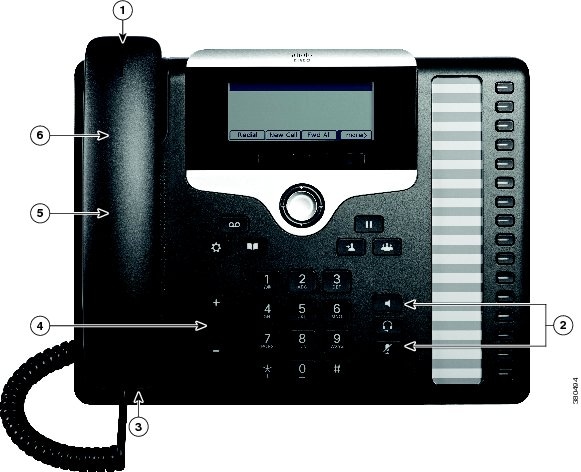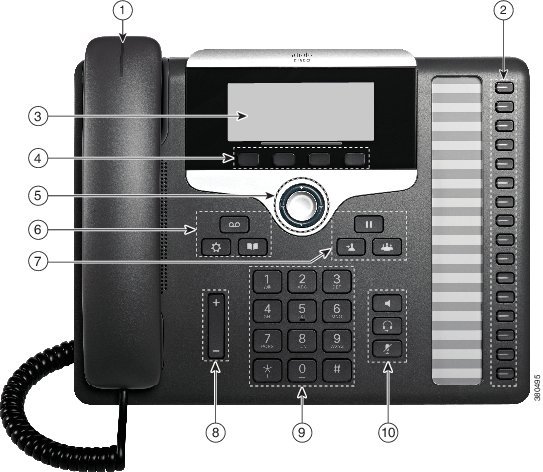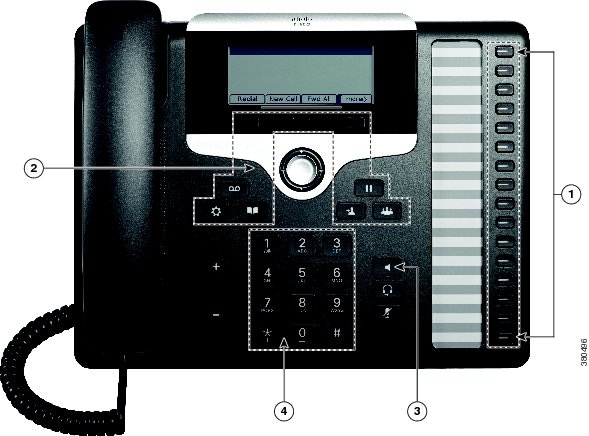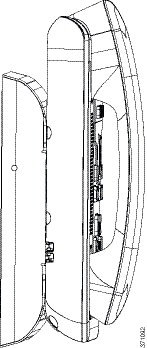Accessibility Features for the Cisco IP Phone 7800 Series
The Cisco IP Phones 7811, 7821, 7841, and 7861 provide accessibility features for the blind, and the visually, hearing, and mobility impaired. Because many of these features are standard, they can be used by users with disabilities without requiring any special configuration.
The Cisco IP Phone 7800 Series has two firmware streams: on-premises and multiplatform phones. The phones with on-premises firmware connect to Cisco products like the Cisco Unified Communications Manager. The multiplatform phones connect to third-party call control systems.
In this document, the term phone support pages refers to the web pages that users can access to set up certain features. For Cisco Unified Communications Manager (Release 10.0 and later), these pages are the Self Care Portal. For Cisco Unified Communications Manager (Release 9.1 and earlier), these pages are the User Options web pages. For Multiplatform Phones, these are the phone web pages.
For additional information, see the phone User Guides:
-
On-Premises Phones: http://www.cisco.com/c/en/us/support/collaboration-endpoints/unified-ip-phone-7800-series/products-user-guide-list.html
-
Multiplatform Phones: https://www.cisco.com/c/en/us/support/collaboration-endpoints/ip-phone-7800-series-multiplatform-firmware/products-user-guide-list.html
Cisco is committed to designing and delivering accessible products and technologies to meet the needs of your organization. You can find more information about Cisco and its commitment to accessibility at this URL: http://www.cisco.com/go/accessibility
New and Changed March 2019
The following changes were made to this document:
-
New content to support Multiplatform Phones
Hearing-Impaired Accessibility Features for On-Premises Phones
Your phone comes with standard accessibility features that require little or no setup.
To check which phone model you have, press Applications ![]() and select Phone information. The Model number field shows your phone model.
and select Phone information. The Model number field shows your phone model.

|
Item |
Accessibility Feature |
Description |
|---|---|---|
|
1 |
Visual message-waiting indicator (handset) |
This lighted strip is visible from all angles. Your phone also provides an audible message-waiting indicator. To change the light or the audible voice-message indicator, sign in to the phone support pages and access the message-indicator settings. You can change each setting to on or off. Your administrator can also change your settings. |
|
2 |
Visual notification of the phone state |
|
|
3 |
Inline-amplifier support (handset) |
Cisco IP Phone handsets support third-party inline amplifiers. You attach an amplifier to the handset and cord and it sits between the handset and the IP phone. |
|
4 |
Adjustable ringtone, pitch, and volume |
Your administrator can also change your settings. |
|
5 |
Hearing aid compatible (HAC) handset |
Supports these accessibility features:
|
|
6 |
Acoustic coupled TTY and TDD support (handset) |
Cisco IP Phones support these TTY and TDD features:
For information about setting up TTY, contact your administrator. |
Hearing-Impaired Accessibility Features for Multiplatform Phones
Your phone comes with standard accessibility features that require little or no setup.
To check which phone model you have, press Applications ![]() and select . The Product name field shows your phone model.
and select . The Product name field shows your phone model.

|
Item |
Accessibility Feature |
Description |
|---|---|---|
|
1 |
Visual message-waiting indicator (handset) |
This lighted strip is visible from all angles. Your phone also provides an audible message-waiting indicator. To change the light or the audible voice-message indicator, sign in to the phone support pages and access the message-indicator settings. You can change each setting to on or off. Your administrator can also change your settings. |
|
2 |
Visual notification of the phone state |
|
|
3 |
Inline-amplifier support (handset) |
Cisco IP Phone handsets support third-party inline amplifiers. You attach an amplifier to the handset and cord and it sits between the handset and the IP phone. |
|
4 |
Adjustable ringtone, pitch, and volume |
Your administrator can also change your settings. |
|
5 |
Hearing aid compatible (HAC) handset |
Supports these accessibility features:
|
|
6 |
Acoustic coupled TTY and TDD support (handset) |
Cisco IP Phones support these TTY and TDD features:
For information about setting up TTY, contact your administrator. |
Vision-Impaired and Blind Accessibility Features for On-Premises Phones
Your phone comes with standard accessibility features that require little or no setup.

|
Item |
Accessibility Feature |
Description |
|---|---|---|
|
1 |
High-contrast visual and audible alert of an incoming call |
Alerts you to an incoming call. The handset light strip flashes during incoming calls and stays lit when a voicemail message is received. |
|
2 |
Line and feature buttons on the Cisco IP Phone
|
Use line buttons to start, answer, or switch to a call on a particular line. Features, such as speed dial, line status, privacy, do not disturb (DND), and service URLs, can be assigned to feature buttons. Your administrator sets up programmable feature buttons on your phone. Colors indicate your phone's status:
|
|
3 |
Back-lit grayscale LCD screen with adjustable contrast on the Cisco IP Phone
|
Allows you to adjust your phone screen's contrast. |
|
4 |
Softkeys
|
Provide access to special functions. The functions are displayed on the LCD. |
|
5 |
Navigation Cluster (includes the Navigation ring and the Select button)
|
Use the Navigation ring to move up and down in the phone LCD. The Select button is in the center of the Navigation cluster. |
|
6 |
Messages button, Applications button, and Contacts button
|
Allow you to easily access your messages, applications, and contacts. |
|
7 |
Hold button, Transfer button, and Conference button
|
Allow you to use these functions on your phone. |
|
8 |
Volume key
|
Allows you to increase or decrease the ring volume or the sound through the handset, headset, or speakerphone. Press up on the rocker key to increase the volume. Press down on the rocker key to decrease the volume. |
|
9 |
Standard 12-key layout |
Allows you to use existing or familiar key positions. Key 5 has a nib. |
|
10 |
Cisco IP Phone 7821, 7841, and 7861:
Cisco IP Phone 7811:
|
Provide audible notification of the phone state:
|
Adjustable Footstand
You can adjust the footstand to either of two viewing angles. This provides optimum phone display viewing and easy access to all buttons and keys.
Vision-Impaired and Blind Accessibility Features for Multiplatform Phones
Your Multiplatform phone comes with standard accessibility features that require little or no setup.

The following table describes the vision-impaired and blind accessibility features on the Cisco IP Phone 7800 Series Multiplatform Phones.
|
Item |
Accessibility Feature |
Description |
|---|---|---|
|
1 |
High-contrast visual and audible alert of an incoming call |
Alerts you to an incoming call. The handset light strip flashes during incoming calls and stays lit when a voicemail message is received. |
|
2 |
Line and feature buttons on the Cisco IP Phone
|
Use line buttons to start, answer, or switch to a call on a particular line. Features, such as speed dial, line status, privacy, do not disturb (DND), and service URLs, can be assigned to feature buttons. Your administrator sets up programmable feature buttons on your phone. Colors indicate your phone's status:
|
|
3 |
Back-lit grayscale LCD screen with adjustable contrast on the Cisco IP Phone
|
Allows you to adjust your phone screen's contrast. |
|
4 |
Softkeys
|
Provide access to special functions. The functions are displayed on the LCD. |
|
5 |
Navigation Cluster (includes the Navigation ring and the Select button)
|
Use the Navigation ring to move up and down in the phone LCD. The Select button is in the center of the Navigation cluster. |
|
6 |
Messages button, Applications button, and Contacts button
|
Allow you to easily access your messages, applications, and contacts. |
|
7 |
Hold button, Transfer button, and Conference button
|
Allow you to use these functions on your phone. |
|
8 |
Volume key
|
Allows you to increase or decrease the ring volume or the sound through the handset, headset, or speakerphone. Press up on the rocker key to increase the volume. Press down on the rocker key to decrease the volume. |
|
9 |
Standard 12-key layout |
Allows you to use existing or familiar key positions. Key 5 has a nib. |
|
10 |
Cisco IP Phone 7821, 7841, and 7861:
Cisco IP Phone 7811:
|
Provide audible notification of the phone state:
|
Adjustable Footstand
You can adjust the footstand to either of two viewing angles. This provides optimum phone display viewing and easy access to all buttons and keys.
Mobility-Impaired Accessibility Features for On-Premises Phones
Your phone comes with standard accessibility features that require little or no setup.
To check which phone model you have, press Applications ![]() and select Phone information. The Model number field shows your phone model.
and select Phone information. The Model number field shows your phone model.

|
Item |
Accessibility Feature |
Description |
|---|---|---|
|
1 |
Lighted buttons on the Cisco IP Phone 7821, 7841, and 7861 The Cisco IP Phone 7811 does not have programmable line buttons. |
Allow you to access the following features:
Indicate your phone's status:
|
|
2 |
Large buttons to access Applications, Messages, Contacts, Hold, Transfer, and Conference |
Allow you to easily access your phone applications, voice messages, corporate and personal directories, and calling features. |
|
3 |
Built-in speakerphone |
Indicates whether the speakerphone is on or off. When the speakerphone is on, the button is lit. |
|
4 |
Tactile-discernible buttons and functions, including a nib on Key 5 |
Allow you to easily locate your phone's keys. For example, Key 5 has a nib, which you can use to locate other key positions. |
Mobility-Impaired Accessibility Features for Multiplatform Phones
Your phone comes with standard accessibility features that require little or no setup.

|
Item |
Accessibility Feature |
Description |
|---|---|---|
|
1 |
Lighted buttons on the Cisco IP Phone 7821, 7841, and 7861 The Cisco IP Phone 7811 does not have programmable line buttons. |
Allow you to access the following features:
Indicate your phone's status:
|
|
2 |
Large buttons to access Applications, Messages, Contacts, Hold, Transfer, and Conference |
Allow you to easily access your phone applications, voice messages, corporate and personal directories, and calling features. |
|
3 |
Built-in speakerphone |
Indicates whether the speakerphone is on or off. When the speakerphone is on, the button is lit. |
|
4 |
Tactile-discernible buttons and functions, including a nib on Key 5 |
Allow you to easily locate your phone's keys. For example, Key 5 has a nib, which you can use to locate other key positions. |
Cisco IP Phone 7800 Series Wall Mount Kit Accessibility
The Cisco IP Phone 7800 Series phones can be mounted on a wall using one of the following wall mount kits:
-
Wallmount Kit for Cisco IP Phone 7811—used to mount a single Cisco IP Phone 7811 on the wall.
-
Wallmount Kit for Cisco IP Phone 7800 Series—used to mount a single Cisco IP Phone 7821 or 7841 on the wall.
-
Wallmount Kit for Cisco IP Phone 7861—used to mount a single Cisco IP Phone 7961 on the wall.
The wall mount kits meet the 307.2 Protrusion Limits section of the Americans with Disabilities Act (ADA) ADAAG requirement for mounting a phone on the wall.
The following figure shows a side view of the phone with the wall mount kit installed.

Third-Party Accessibility Applications
Cisco works closely with partners to provide solutions that complement the accessibility and usability of Cisco products and solutions. There are third-party applications such as real-time captioning on Cisco IP Phones, Text Telephones for the Deaf (TDD/TTY), Real Time Text (RTT), hearing/voice carry over (HCO/VCO), audible caller ID, inline amplifiers for handsets for louder call sound, "busy lights", audio/visual emergency notifications through Cisco IP Phones (supporting users with disabilities), etc.
Here's a link to a presentation about all the accessibility features of Cisco Unified Communications products, and some third party assistive technology which works with it:
For more information about third-party applications, contact your administrator.
Cisco Unified Communications Manager Accessibility Features
The following table provides information on the Cisco Unified Communications Manager (Cisco Unified CM) accessibility features. For more information, see the user guide applicable to your phone.
|
Accessibility Feature |
Description |
Configuration Requirements |
|---|---|---|
|
Programmable Line Key (PLK) |
You can use the line buttons to initiate, answer, or switch to a call on a particular line. A limited number of features, such as speed dial, extension mobility, privacy, Busy Lamp Field (BLF) speed dial, Do Not Disturb (DND), and Service URLs, get assigned to these buttons. The PLK feature expands the features that can be assigned to the line buttons to include those that softkeys normally control; for example New Call, Call Back, End Call, and Forward All. When these features are configured on the line buttons, they are always visible, so you can have a “hard” New Call key. You can access features easily that may be assigned to softkeys normally, which can be too small and difficult to use. |
Standard on all Cisco IP Phones; configuration is required. Your administrator assigns PLKs to your phone. |
|
Audible Message Waiting Indicator (AMWI) |
Cisco Unified IP Phones can send a line-specific stutter dial tone when a voice message is waiting on the phone. You hear it only when using the line with the waiting messages. When you go off hook (on the line for which a voice message has been left), the stutter dial tone is heard. You can change the audible voice-message indicator setting by logging in to your phone support pages, and changing the audible message-indicator setting to On or Off. |
Standard on all Cisco IP Phones. Configuration is required:
|
|
Do Not Disturb (Alert and Reject) |
Your administrator configures the phone to turn on all audible and visual notifications, turn on ringer only, or to choose the type of alert a phone should play for incoming calls. |
Standard on all Cisco IP Phones; configuration is required. |
|
Busy Lamp Field |
You can use the Busy Lamp Field (BLF) feature to monitor the call state of a directory number (DN) associated with a speed-dial button, call log, or directory listing on the phone. In addition, you can use BLF pickup to monitor incoming calls on a directory number. When the DN receives an incoming call, the system alerts the you so that you can then pick up the call. |
Standard on all Cisco IP Phones; configuration is required. |
|
Phone support pages:
|
The Cisco IP Phone is a network device that enables you to do the following actions:
|
Standard on all Cisco IP Phones; configuration is required. |
 Feedback
Feedback